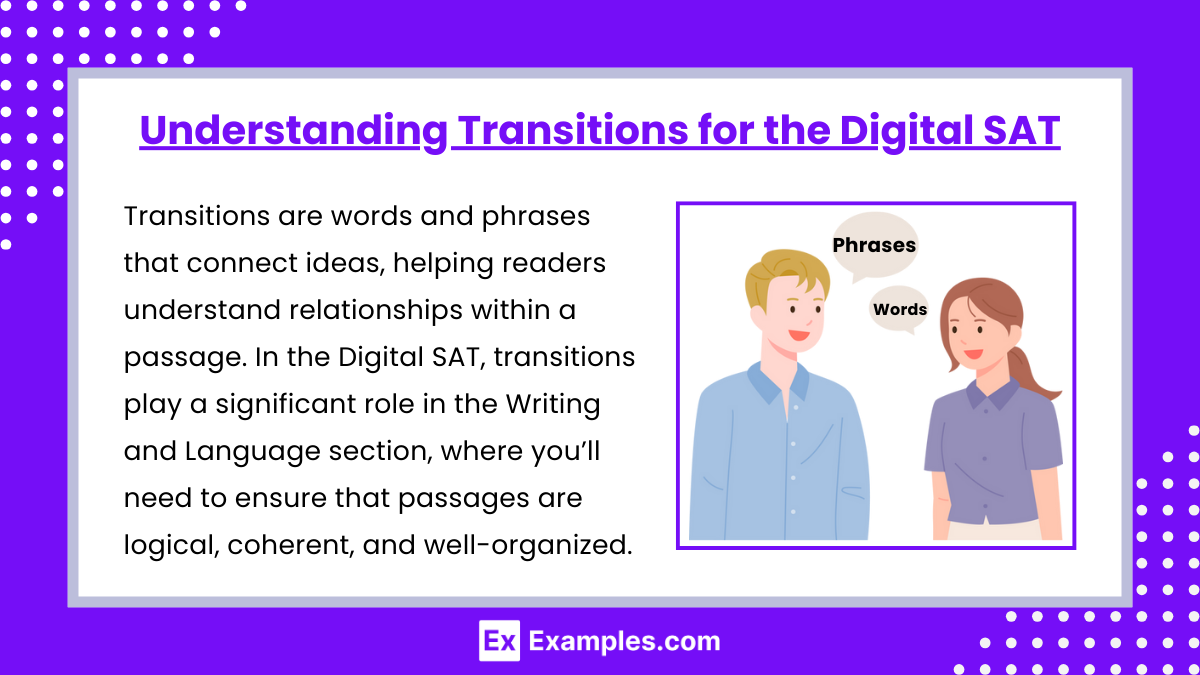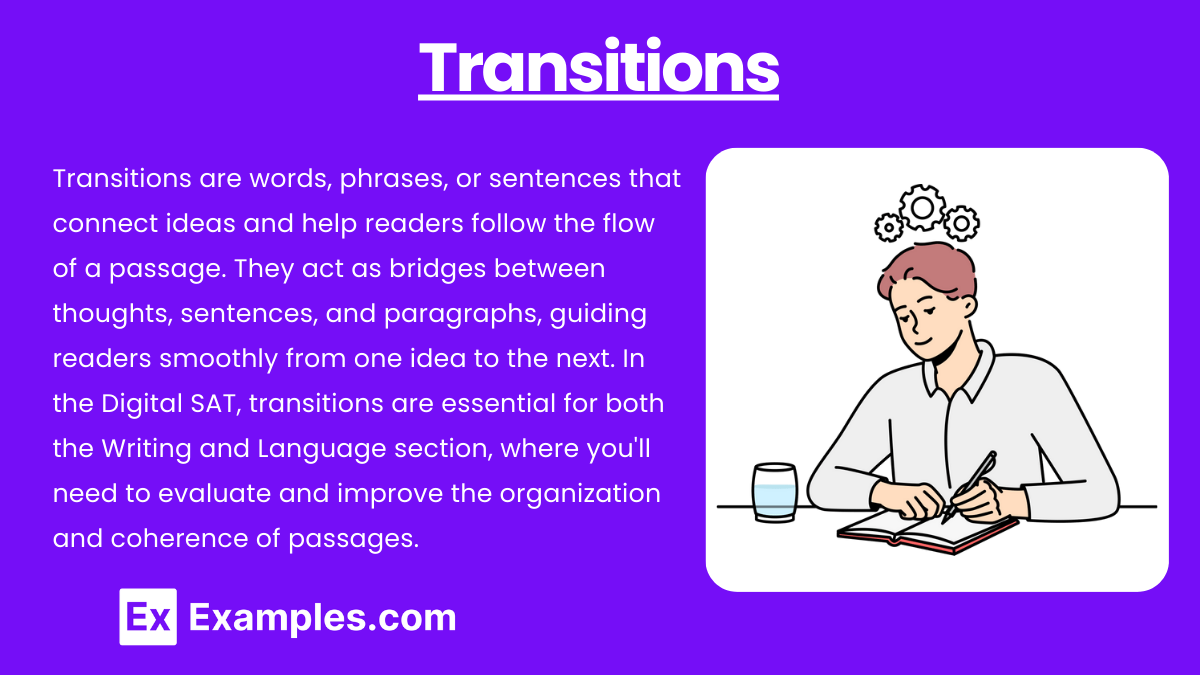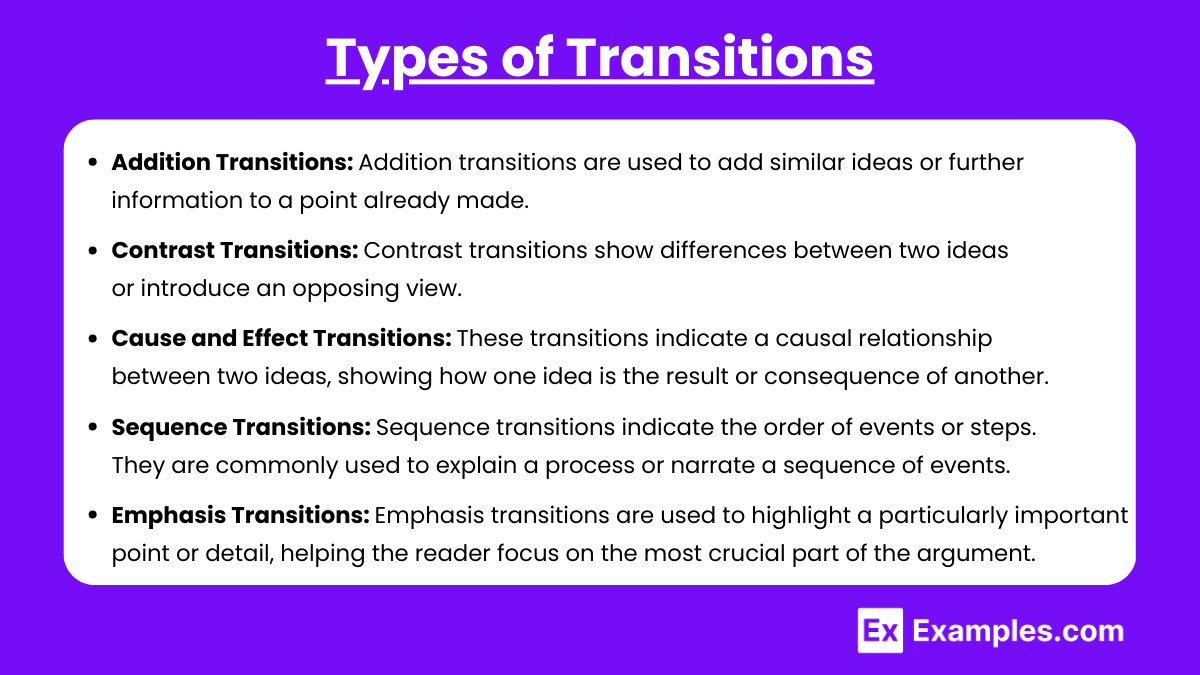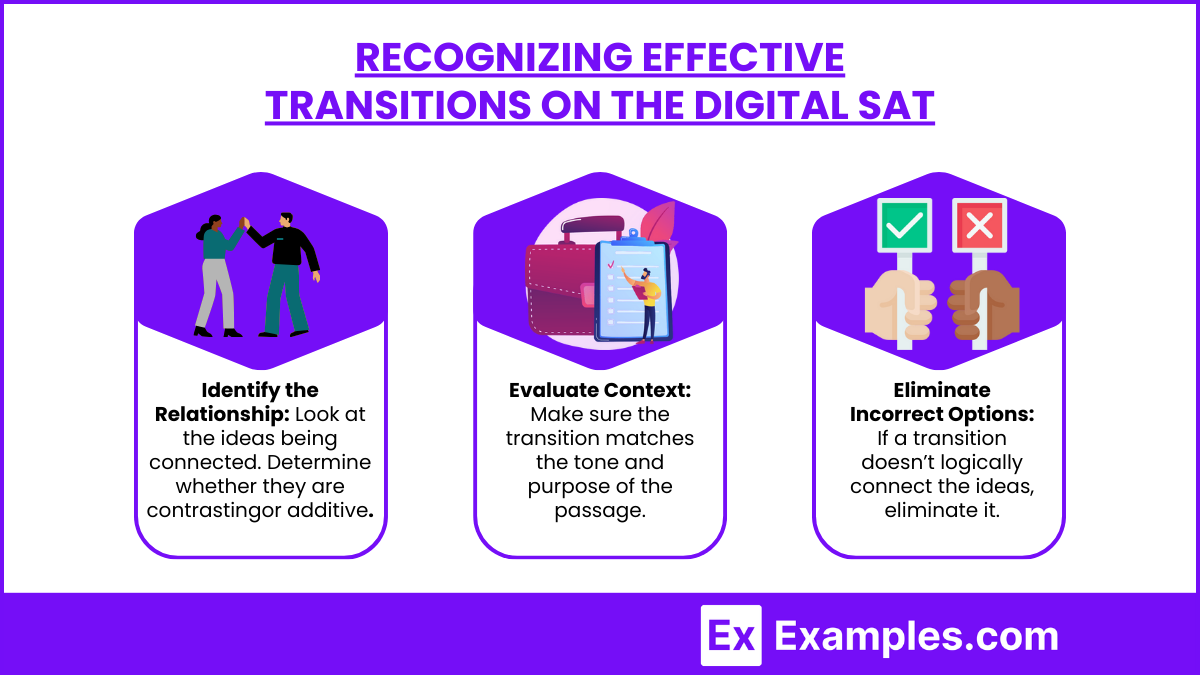Transitions are essential tools for clear and cohesive writing, guiding readers smoothly between ideas. On the Digital SAT, mastering transitions can help improve coherence and flow within passages. Understanding different transition types, such as addition, contrast, cause and effect, and sequence, is key to choosing the right words and achieving a high score in the Writing and Language section.
Learning Objectives
In studying “Transitions” for the Digital SAT, you should learn to identify and apply appropriate transitional words and phrases to establish clear and logical relationships between ideas in a passage. Analyze how transitions enhance coherence by indicating comparisons, contrasts, cause-and-effect relationships, or sequence of events. Practice recognizing the most effective transition for improving the flow of a text. Additionally, understand how transitions contribute to clarity, argument development, and the reader’s comprehension in writing.
Understanding Transitions for the Digital SAT

Transitions are words and phrases that connect ideas, helping readers understand relationships within a passage. In the Digital SAT, transitions play a significant role in the Writing and Language section, where you’ll need to ensure that passages are logical, coherent, and well-organized. By mastering transitions, you can greatly improve the flow of ideas and effectively link sentences and paragraphs, leading to a higher score.
Transitions

Transitions are words, phrases, or sentences that connect ideas and help readers follow the flow of a passage. They act as bridges between thoughts, sentences, and paragraphs, guiding readers smoothly from one idea to the next. In the Digital SAT, transitions are essential for both the Writing and Language section, where you’ll need to evaluate and improve the organization and coherence of passages.
Using the right transition words can make writing clear and logical. They can indicate relationships between ideas such as addition, contrast, cause and effect, sequence, and emphasis.
Types of Transitions

Here are the primary types of transitions you will encounter on the Digital SAT:
1. Addition Transitions
Addition transitions are used to add similar ideas or further information to a point already made. These transitions make writing more comprehensive by building on the previous idea.
Examples:
- Words/Phrases: Furthermore, Additionally, In addition, Also, Moreover, Similarly, Besides
- Use in Sentences:
- “The program helps students with time management. Additionally, it offers guidance on note-taking skills.”
- “He enjoys playing the guitar. Moreover, he is an excellent singer.”
2. Contrast Transitions
Contrast transitions show differences between two ideas or introduce an opposing view. They are helpful when comparing or contrasting points.
Examples:
- Words/Phrases: However, On the other hand, In contrast, Although, Yet, Nevertheless, Nonetheless, Despite this
- Use in Sentences:
- “She wanted to study history. However, her parents encouraged her to pursue engineering.”
- “The weather was predicted to be sunny. Yet, it rained heavily in the afternoon.”
3. Cause and Effect Transitions
These transitions indicate a causal relationship between two ideas, showing how one idea is the result or consequence of another.
Examples:
- Words/Phrases: Therefore, As a result, Consequently, Thus, Hence, For this reason, Because of this
- Use in Sentences:
- “The company was losing money. Therefore, they decided to cut costs.”
- “She didn’t prepare for the test. As a result, she didn’t score well.”
4. Sequence Transitions
Sequence transitions indicate the order of events or steps. They are commonly used to explain a process or narrate a sequence of events.
Examples:
- Words/Phrases: First, Second, Next, Then, Finally, Afterwards, Subsequently, At this point
- Use in Sentences:
- “First, mix the ingredients thoroughly. Next, bake the mixture for 20 minutes.”
- “She completed the project. Then, she submitted it to her professor.”
5. Emphasis Transitions
Emphasis transitions are used to highlight a particularly important point or detail, helping the reader focus on the most crucial part of the argument.
Examples:
- Words/Phrases: Indeed, In fact, Most importantly, Above all, Certainly, Without a doubt
- Use in Sentences:
- “Indeed, he is the most talented player on the team.”
- “The project was challenging. Above all, it required teamwork and dedication.”
Recognizing Effective Transitions on the Digital SAT

In the Writing and Language section, you’ll need to choose the best transition word or phrase that fits within the context of a passage. Here’s what to keep in mind:
- Identify the Relationship: Look at the ideas being connected. Determine whether they are contrasting, sequential, cause-and-effect, or additive.
- Evaluate Context: Make sure the transition matches the tone and purpose of the passage. For example, if the passage presents a problem and then a solution, a cause-and-effect transition might be appropriate.
- Eliminate Incorrect Options: If a transition doesn’t logically connect the ideas, eliminate it. There’s usually only one choice that best maintains coherence.
Examples
Example 1: Addition Transition
“Volunteering can greatly benefit a person’s emotional well-being. In addition, it provides valuable opportunities to develop new skills. Many people find that by engaging in volunteer work, they not only feel a sense of purpose but also learn things like leadership, time management, and communication. Moreover, volunteering can help individuals expand their social network by connecting them with like-minded people.”
Example 2: Contrast Transition
“Many people believe that exercising only benefits physical health. However, research shows that exercise also has significant mental health benefits. Regular physical activity can help reduce symptoms of anxiety and depression. On the other hand, failing to engage in physical activity may lead to increased stress and lower overall mood.”
Example 3: Cause and Effect Transition
“John neglected to review his notes before the exam. As a result, he struggled to recall key information during the test. His performance reflected his lack of preparation, and his grade suffered. Therefore, he decided to change his study habits and start preparing earlier for future exams.”
Example 4: Sequence Transition
“To bake a cake, you need to follow several steps carefully. First, gather all the ingredients, such as flour, sugar, eggs, and butter. Next, mix the dry ingredients together in a bowl. Then, add the wet ingredients and stir until smooth. Finally, pour the batter into a pan and bake it in the oven at 350°F for 30 minutes.”
Example 5: Emphasis Transition
Regular exercise is beneficial for physical health, but it also plays a crucial role in mental well-being. Indeed, studies show that even moderate exercise can significantly reduce symptoms of anxiety and depression. By staying active, individuals not only improve their mood but also enhance cognitive function and resilience. Without a doubt, incorporating physical activity into one’s daily routine can lead to substantial overall health improvements.
Practice Questions
Question 1:
“Maria loves to travel and explore new places. __, she enjoys trying different cuisines and learning about local cultures.”
A) However
B) Additionally
C) Therefore
D) Consequently
Correct Answer: B) Additionally
Explanation: The sentence lists two related activities that Maria enjoys: traveling and experiencing local cultures. “Additionally” is an addition transition that introduces a related idea, making it the most appropriate choice to connect these two hobbies. Other options do not indicate addition: “However” introduces contrast, “Therefore” indicates cause and effect, and “Consequently” implies a result, none of which fit the context here.
Question 2:
“Many species have adapted to survive in harsh desert climates. __, these species often face threats from habitat destruction and climate change.”
A) Furthermore
B) In contrast
C) As a result
D) Although
Correct Answer: A) Furthermore
Explanation: The sentence first mentions adaptation, then introduces additional threats to the species, both related to their survival. “Furthermore” adds new but related information, making it the best addition transition here. “In contrast” would suggest an opposing idea, which is not present. “As a result” would imply a cause-and-effect relationship that is not expressed in the sentence, and “Although” introduces contrast, which is not relevant here.
Question 3:
“The project was initially challenging. __, with proper teamwork and dedication, it was completed ahead of schedule.”
A) Nevertheless
B) For example
C) In other words
D) Meanwhile
Correct Answer: A) Nevertheless
Explanation: The first sentence describes the project as challenging, and the second sentence shows that despite this, the project was completed successfully. “Nevertheless” is a contrast transition that effectively shows that the outcome was positive despite the initial difficulty. “For example” would introduce a specific instance, which is not relevant here. “In other words” would rephrase, not contrast, and “Meanwhile” suggests simultaneous events, which does not match the context.


